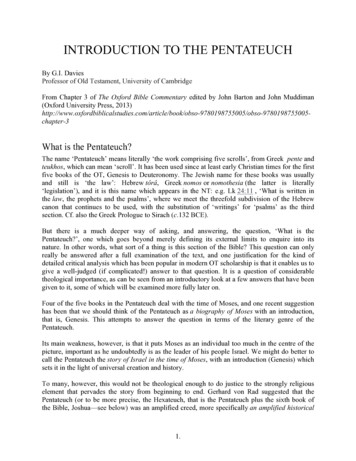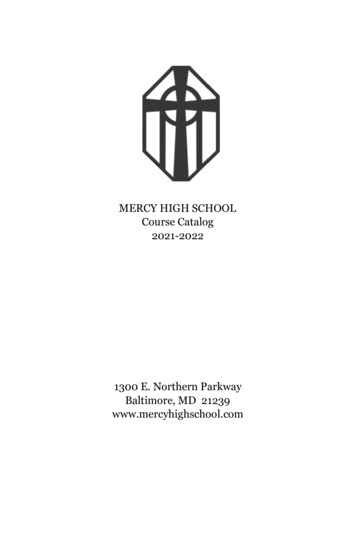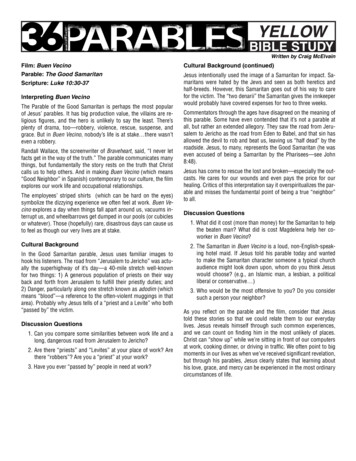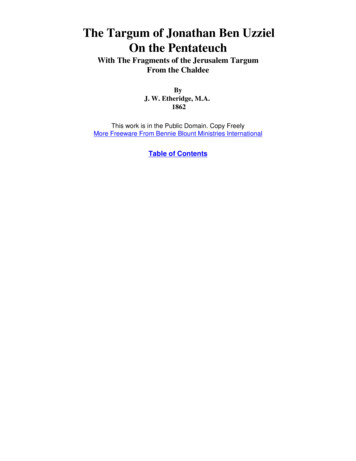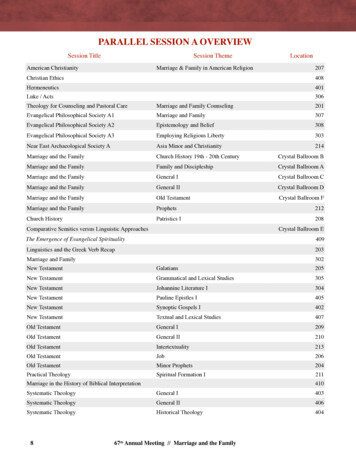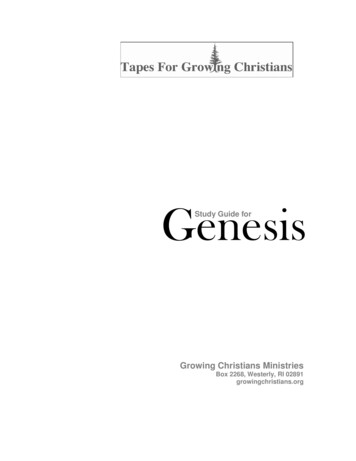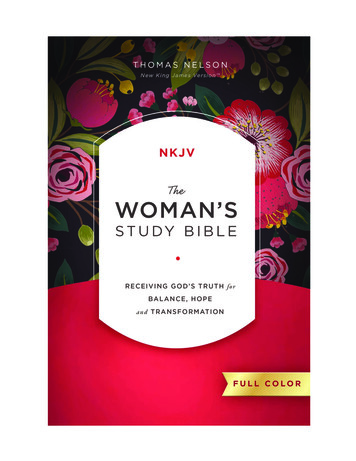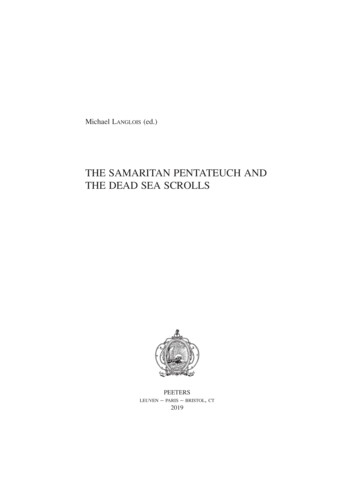
Transcription
Michael LANGLOIS (ed.)THE SAMARITAN PENTATEUCH ANDTHE DEAD SEA SCROLLSLEUVEN100950 Langlois CBET 94 00b vw.indd III–PEETERSPARIS – BRISTOL,2019CT1/03/19 06:51
A catalogue record for this book is available from the Library of Congress. 2019 — Peeters, Bondgenotenlaan 153, B-3000 LeuvenISBN 978-90-429-3783-3eISBN 978-90-429-3784-0D/2019/0602/17All rights reserved. No part of this publication may be reproduced, stored in aretrieval system, or transmitted, in any form or by any means, electronic, mechanical, photocopying, recording or otherwise, without the prior permission of thepublisher.100950 Langlois CBET 94 00b vw.indd IV1/03/19 06:51
In Memoriam Gary N. Knoppers (1956–2018)100950 Langlois CBET 94 00b vw.indd V1/03/19 06:51
100950 Langlois CBET 94 00b vw.indd VI1/03/19 06:51
TABLE OF CONTENTSMagnar KARTVEITScholars’ Assessments of the Relationship between the Pre-SamaritanTexts and the Samaritan Pentateuch. . . . . . . . . . . . . . . . .1Emanuel TOVFrom Popular Jewish LXX-SP Texts to Separate Sectarian Texts:Insights from the Dead Sea Scrolls . . . . . . . . . . . . . . . . .19Michaël N. VAN DER MEERExclusion and Expansion: Harmonisations in the Samaritan Pentateuch, Pre-Samaritan Pentateuchal Manuscripts and Non-PentateuchalManuscripts . . . . . . . . . . . . . . . . . . . . . . . . . . . . .41Stefan SCHORCHThe So-Called Gerizim Commandment in the Samaritan Pentateuch77Gary N. KNOPPERS †Altared States: The Altar Laws in the Samaritan and Jewish Pentateuchs, and Their Early Interpreters . . . . . . . . . . . . . . . . .99Benjamin ZIEMERA Stemma for Deuteronomy . . . . . . . . . . . . . . . . . . . . . 127Innocent HIMBAZALooking at the Samaritan Pentateuch from Qumran: Legal Materialof Leviticus and Deuteronomy . . . . . . . . . . . . . . . . . . . 199Jonathan BEN-DOVText Duplications between Higher and Lower Criticism: Num 20-21and Deut 2-3 . . . . . . . . . . . . . . . . . . . . . . . . . . . . . 217Abraham TALDo the Samaritan Pentateuch and 1QIsaᵃ Follow the Same Model? 243Michael LANGLOISDead Sea Scrolls Palaeography and the Samaritan Pentateuch . . 255100950 Langlois CBET 94 00b vw.indd IX1/03/19 06:51
XTABLE OF CONTENTSChristian STADELVariegation in Second Temple Period Hebrew: Passive t-Stems, the הלז Demonstrative Series, and אפוא in Samaritan Hebrew and in theDead Sea Scrolls . . . . . . . . . . . . . . . . . . . . . . . . . . . 287Jan JOOSTENBiblical Interpretation in the Samareitikon as Exemplified in Anonymous Readings in Leviticus Attested in M′ . . . . . . . . . . . . . 313100950 Langlois CBET 94 00b vw.indd X1/03/19 06:51
DEAD SEA SCROLLS PALAEOGRAPHY ANDTHE SAMARITAN PENTATEUCHMichael LANGLOISSeventy years after their discovery, the Dead Sea Scrolls continue toshed light on the Samaritan Pentateuch. In this contribution, I would liketo focus on palaeography and explore two ways in which the study of thescribal hands that copied the scrolls may be relevant to the history of theSamaritan Pentateuch ( ). In the first part, we will examine the scripts ofbiblical Dead Sea Scrolls allegedly close to and date their copy on thebasis of their palaeographical features. These dates will be used as boundaries for various stages of the redaction history of or its ancestors.In the second part, we will examine the so-called “Palaeo-Hebrew” scriptused by a few Dead Sea Scrolls. Taking into account other attestations ofthis script, we will outline its development and conclude as to the historyof the Samaritan script.1. THEDEAD SEA SCROLLS RELATED TOSAMARITAN PENTATEUCHSCRIPTS OF BIBLICALTHEIn their recent synthesis, Anderson and Giles1 mention the followingDead Sea Scrolls as preserving a possible pre-Samaritan text: 4Q17(4QExod-Levᶠ); 4Q22 (4QpaleoExodᵐ); 4Q27 (4QNumᵇ); 4Q158 and4Q364–367 (4QRP); and perhaps 4Q26 (4QLevᵈ). They also refer to4Q37 (4QDeutʲ), 4Q38 (4QDeutᵏ¹), and 4Q41 (4QDeutn), whose relationto is debated. I will refrain, at this stage, from discussing the allegedrelationship of these manuscripts to , but rather focus on their palaeographical features. I will also add to this list 4Q45 (4QpaleoDeutʳ), whichis one of the closest scrolls to for the book of Deuteronomy, according1Robert T. Anderson and Terry Giles, The Samaritan Pentateuch: An Introduction to Its Origin, History, and Significance for Biblical Studies, Resources for Biblical Study 72(Atlanta: Society of Biblical Literature, 2012), 46–47.100950 Langlois CBET 94 10 Langlois.indd 2551/03/19 06:53
256MICHAEL LANGLOISto Ziemer.2 Unless stated otherwise, the analyses presented below arebased on the examination of high-resolution photographs provided by theIsrael Antiquities, either on their dedicated website3 or directly to me uponspecial request.4 I refrained from consulting previous palaeographicalstudies of these scrolls in order to avoid any bias. My conclusions werethen (and only then) compared to previous studies, and their differences(if any) are briefly discussed below. The thirteen manuscripts will nowbe presented according to their inventory numbers.4Q17 (4QExod-Levᶠ)5The script of this manuscript is rather naïve. The calamus is not beveled, and the letters are quite big, with an average caliber of 2.5 0.5 mm.Several features indicate a pre-Hasmonaean period: the absence of medialforms for כ and נ , the narrow ל , etc. Compared to an ostracon fromMaresha dated to 136 of the Seleucid era (i.e. 176 BCE),6 some lettersseem to be drawn with an older ductus, such as the ת with a longer leftleg and the absence of final ם and medial נ . I conclude that this manuscript was probably copied around the second half of the third centuryBCE. Cross dates it “to the mid-third century CBE”,7 which is possible,but I would not go much earlier.4Q22 (4QpaleoExodᵐ)This manuscript is one of the few Dead Sea Scrolls that have beencopied using the so-called “Palaeo-Hebrew” script; it will therefore bedealt with in the second part of this study. As we will see, it may havebeen copied sometime in the second half of the second century BCE orduring the early first century BCE.234567See his contribution to this volume pp. 127ff.The Leon Levy Dead Sea Scrolls Digital Library, http://www.deadseascrolls.org.il/.I want to thank Pnina Shor, Oren Ableman, Orit Rosengarten-Kuslansky, Shai Haleviand Yael Barschak for their kindness and support.Frank Moore Cross, “17. 4QExod-Levᶠ,” in Qumran Cave 4. VII. Genesis to Numbers, Discoveries in the Judaean Desert XII (Oxford: Clarendon Press, 1994), 133–44.Esther Eshel and Amos Kloner, “An Aramaic Ostracon of an Edomite Marriage Contract from Maresha, Dated 176 B.C.E.,” Israel Exploration Journal 46.1/2 (1996):1–22.Cross, “17. 4QExod-Levᶠ,” 134.100950 Langlois CBET 94 10 Langlois.indd 2561/03/19 06:53
DEAD SEA SCROLLS PALAEOGRAPHY AND THE SAMARITAN PENTATEUCH2574Q26 (4QLevᵈ)84Q26 is one of the scrolls whose relation to is debated.9 It is preserved by a few damaged fragments, which complicates the palaeographicalanalysis. The hand is confident; the script is formal, spacious, regular. ה features a thick protruding traverse; the top of ל is thickened, and some ל have an angular hook; ג is symmetrical; ב is drawn without lifting thepen; ת features an angular foot.Overall, no clear Herodian features can be detected. I conclude that thisscroll was copied sometime in the middle of the first century BCE. TheDJD editor does not discuss the palaeographical features, whereas Eshelqualifies the script as “early Herodian” to be dated “between 30 BCE and20 CE,” pointing similarities with 4QNumᵇ.10 But as we will see below,4QNumᵇ is more at home in the mid-first century BCE or shortly after;I believe it may also be the case with 4QLevᵈ, though its fragmentarycondition prevents a more accurate dating.4Q27 (4QNumᵇ)11The hand of the scribe who copied this scroll is skilled, confident, andconsistent. י and ו are penned in a similar way and can easily be confused,which is typical of first century BCE scripts. The head of ל is thickened. ב is drawn without lifting the pen, as opposed to the two-step ductus (witha left-to-right base protruding to the right) that develops in the Herodianperiod. Final ם features a triangular ornament at the left, which suggestsfurther development from Hasmonaean hands. א sometimes has a tick atthe bottom of the left leg as well as that of the diagonal; this is alsoindicative of a late Hasmonaean to early Herodian period. ג , on the contrary, features symmetrical legs, unlike the later Hasmonaean shape.I conclude that this scroll was copied around the mid-first century BCE,preferably in the third quarter, but not much later. Jastram mentions Cross’dating between 30 BCE to 20 CE, but adds that in a personal communication Cross expressed a “preference for the earlier portion of that range,” a891011Emanuel Tov, “26. 4QLevd,” in Qumran Cave 4. VII: Genesis to Numbers, Discoveriesin the Judaean Desert XII (Oxford: Clarendon Press, 1994), 193–95.See, in this volume, the contribution by Michaël van der Meer pp. 41ff.Esther Eshel, “4QLevd: A Possible Source for the Temple Scroll and Miqṣat Ma aśe Ha-Torah,” DSD 2.1 (1995): 1.Nathan Jastram, “27. 4QNumb,” in Qumran Cave 4. VII. Genesis to Numbers, Discoveriesin the Judaean Desert XII (Oxford: Clarendon Press, 1994), 205–67.100950 Langlois CBET 94 10 Langlois.indd 2571/03/19 06:53
258MICHAEL LANGLOISconclusion that Jastram adopts.12 Not only was Cross right in preferringthe earlier portion of his range, but I believe that the third quarter wouldeven be better given the relatively few Herodian features.4Q37 (4QDeutj)13This is one of the scrolls whose relation to is debated and complicated by its composite nature.14 It was copied by a trained scribe in aformal script; several Herodian features can be observed: the upper armof א is sometimes ornamented; ב is penned in two steps, with the basedrawn from left to right and protruding to the right; ג is made up of aslanted vertical and an oblique left leg. ד features two horns: the left hornis a slightly slanted tick, while the right horn is sometimes drawn as atriangular loop joining the traverse and the leg. ל has a fully developedhook, but little or no upper tick. ק features a triangular loop joining thevertical and the traverse.All these features are consistent with a typical developed Herodianformal script. Few late Herodian features are detected, which leads meto conclude that this scroll was probably copied in the first half of thefirst century CE, preferably around the second quarter. Cross dates it toca. 50 CE, which is possible, but I want to emphasize that the script isnot as typologically “late” as other late Herodian scrolls.154Q38 (4QDeutᵏ¹)164Q38 is one of the scrolls whose relation to is debated and complicated by its composite nature.17 The DJD edition consists of one largefragment and four small fragments. My analysis is based on frag. 2,which was copied by a somewhat inconsistent hand; the strokes are not121314151617Jastram, “27. 4QNumb,” 211.Julie Ann Duncan, “37. 4QDeutj,” in Qumran Cave 4. IX. Deuteronomy, Joshua, Judges, Kings, ed. Eugene C. Ulrich et al., Discoveries in the Judaean Desert XIV (Oxford:Clarendon Press, 1995), 75–91.See the contributions by Benjamin Ziemer and Emanuel Tov in the present volume,pp. 127ff and 19ff respectively.Frank Moore Cross, “The Development of the Jewish Scripts,” in The Bible and the Ancient Near East. Essays in Honor of William Foxwell Albright, ed. G. Ernest Wright(London: Routledge & Kegan Paul, 1961), 139.Julie Ann Duncan, “38. 4QDeutk1,” in Qumran Cave 4. IX. Deuteronomy, Joshua, Judges, Kings, ed. Eugene C. Ulrich et al., Discoveries in the Judaean Desert XIV(Oxford: Clarendon Press, 1995), 93–98.See the contributions by Benjamin Ziemer and Emanuel Tov in the present volume,pp. 127ff and 19ff respectively.100950 Langlois CBET 94 10 Langlois.indd 2581/03/19 06:53
DEAD SEA SCROLLS PALAEOGRAPHY AND THE SAMARITAN PENTATEUCH259always very precise, and the ductus can vary. The script is semiformaland exhibits cursive features as well as a tendency to add curved ornamentations (see for instance ע , ש , sometimes א , and so on). ל features arounded hook of varying size, sometimes almost closed. ה features adouble traverse, while ש has a descending left stroke.These features can already be observed in semicursive scripts in theHasmonaean period, and it is difficult to know when they impregnatedformal hands. But since no typical Herodian development can be observed,I conclude that this fragment was likely copied in the second half of thefirst century BCE. The DJD editor dates it to ca. 30–1 BCE,18 which ispossible, though I would not exclude a slightly earlier date due to theinfluence of semicursive ductus.4Q41 (4QDeutn)19The relation of this beautiful scroll to is likewise complicated byits composite nature.20 It contains two sheets; the first one contains onecolumn, while the second contains five columns. They have been copiedby the same scribe. The script is quite small, partially regular; the sizeof final ך and ם are reminiscent of a second-century BCE ductus, butmost features are otherwise in line with first-century Hasmonaean scripts. ע is quite developed, as is י which can easily be confused with ל . ו featuresthickening at its top by means of a forward loop. The left leg of א sometimes joins the diagonal at its top, but is not drawn together with it. ב isdrawn without lifting the pen. ת features a sometimes longer right leg,especially (but not exclusively) in final position.All these characteristics lead me to conclude that this manuscript wascopied around the first half of the first century BCE, preferably aroundthe second quarter. The DJD editor dates it to ca. 30–1 BCE,21 but she ismislead in her palaeographical analysis: א does not use “the ‘inverted-v’form”; when the left stroke joins the diagonal at its top, it is nonetheless18192021Duncan, “38. 4QDeutk1,” 94.Sidnie White Crawford, “41. 4QDeutn,” in Qumran Cave 4. IX. Deuteronomy, Joshua, Judges, Kings, ed. Eugene C. Ulrich et al., Discoveries in the Judaean Desert XIV (Oxford:Clarendon Press, 1995), 93–98.Elizabeth Owen, “4QDeutn: A Pre-Samaritan Text?,” Dead Sea Discoveries 4.2 (1997):162–78; Sidnie White Crawford, “A Response to Elizabeth Owen’s ‘4QDeutn: A PreSamaritan Text?,’” Dead Sea Discoveries 5.1 (1998): 92–94. See also the contributions by Benjamin Ziemer and Emanuel Tov in the present volume, pp. 127ff and 19ffrespectively.White Crawford, “41. 4QDeutn,” 117–18.100950 Langlois CBET 94 10 Langlois.indd 2591/03/19 06:53
260MICHAEL LANGLOISdrawn separately. Likewise, the base of ב is not “penned from left toright.” I agree with her that ו and י can sometimes be confused, which isusually indicative of the second half of the first century BCE, but I wouldnot consider it “a sure sign of an early Herodian hand.” My preferencefor the second quarter rather than the first is in part due to this confusionof ו and י , but the last third of the century is typologically too late.4Q45 (4QpaleoDeutr)This manuscript is one of the few Dead Sea Scrolls that have been copiedusing the so-called “Palaeo-Hebrew” script; it will therefore be dealt within the second part of this study. As we will see, it may have been copiedsometime in the second half of the second century BCE or during the earlyfirst century BCE.4Q158 (4QRPᵃ)22The hand of the scribe who copied 4Q158 is skilled and confident. FewHerodian features can be observed, such as the forward triangular thickeningon top of ל that develops from the late Hasmonaean thickening and anticipates the late Herodian tick. The ductus of מ with a left oblique tick ratherthan a loop is also indicative. ג features an asymmetrical shape, but othershapes are more conservative: א , ע , final ך , etc. I conclude that this scrollwas probably copied around the last third of the first century BCE. Allegrodoes not discuss the palaeography of this scroll; in his review article,Strugnell qualifies the hand as “formelle, hérodienne ou légèrement préhérodienne.”23 The conservative shapes of some letters, which I mentionedabove, probably led him to consider a possible pre-Herodian dating; but thepresence of more developed shapes favors the early Herodian period.4Q364 (4QRPᵇ)24As I worked on the upcoming volume Gleanings from the Caves, I studied a small fragment labeled MS 5439/1.25 Very few letters were attested,22232425John Marco Allegro, Qumrân Cave 4. I (4Q158–4Q186), Discoveries in the JudaeanDesert of Jordan V (Oxford: Clarendon Press, 1968), 1–6.John Strugnell, “Notes en marge du volume V des « Discoveries in the Judaean Desertof Jordan »,” Revue de Qumrân 7.2 (26) (1970): 168.Emanuel Tov and Sidnie White, “364. Reworked Pentateuchb,” in Qumran Cave 4. VIII. Parabiblical Texts, Part 1, Discoveries in the Judaean Desert XIII (Oxford: Clarendon Press, 1994), 197–254.Michael Langlois, “Palaeographical Analysis of the Dead Sea Scrolls in The SchøyenCollection,” in Gleanings from the Caves. Dead Sea Scrolls and Artefacts from The 100950 Langlois CBET 94 10 Langlois.indd 2601/03/19 06:53
DEAD SEA SCROLLS PALAEOGRAPHY AND THE SAMARITAN PENTATEUCH261but they all were consistent with a second-century BCE palaeographicaldating. Later, this fragment was identified as belonging to 4Q364. I was thusable to study the shape of letters that were not attested on the fragment;some of them were slightly more developed, which led me to conclude thatthis scroll was copied in the second half of the second century BCE. Thedate suggested by the editors of 4Q364, “late Hasmonean or transitional,”26is too late. Puech wrongly attributed this fragment to 4Q1, but his dating “dela deuxième moitié du IIe siècle avant J.-C.”27 is correct.4Q365 (4QRPᶜ)28The script of this manuscript is naïve and semi-formal. The pen is notbeveled; the scribe likes refined, recurved strokes. ש has an angled rightstroke; ע features an elbow and horizontal base; ג is symmetrical (unlikethe later Herodian ductus); פ has a large curled head; ל has a thickenedtop. ב is sometimes penned without lifting the pen, with a concave rightto-left base, and sometimes in the new two-step ductus; ו and י are bothshort and can easily be confused.I conclude that the scroll was copied around the second half of thefirst century BCE. I agree with the DJD editors who qualify the scriptas “transitional between the late Hasmonaean and early Herodianperiods.”29This scroll may have been tested for radiocarbon dating:30 according toDoudna, the “Pentateuchal paraphrase” tested in Zurich31 is an “Additional262728293031Schøyen Collection, ed. Torleif Elgvin, Kipp Davis, and Michael Langlois, Library ofSecond Temple Studies 71 (London: Bloomsbury T&T Clark, 2016), 81–82.Tov and White, “364. Reworked Pentateuchb,” 201.Émile Puech, “Un nouveau fragment 7a de 4QGn-Exa 4QGn-Ex 1 et quelques nouvelles lectures et identifications du manuscrit 4Q1,” Revue de Qumrân 25.1 (2011): 105.Emanuel Tov and Sidnie White, “365. Reworked Pentateuchᶜ,” in Qumran Cave 4. VIII. Parabiblical Texts, Part 1, Discoveries in the Judaean Desert XIII (Oxford: Clarendon Press, 1994), 255–318.Tov and White, “365. Reworked Pentateuchᶜ,” 260.Two sets of radiocarbon tests were performed on Dead Sea Scrolls: Georges Bonaniet al., “Radiocarbon Dating of Fourteen Dead Sea Scrolls,” Radiocarbon 34.3 (1992):843–49; Timothy A. J. Jull et al., “Radiocarbon Dating of Scrolls and Linen Fragmentsfrom the Judean Desert,” Radiocarbon 37.1 (1995): 11–19. See recently Johannes vander Plicht and Kaare L. Rasmussen, “Radiocarbon Dating and Qumran,” in Holistic Qumran: Trans-Disciplinary Research of Qumran and the Dead Sea Scrolls. Proceedings of the NIAS-Lorentz Center Qumran Workshop, 21-25 April 2008, ed. Jan Gunneweg,Annemie Adriaens, and Joris Dik, Studies on the Texts of the Desert of Judah 87 (Leiden:Brill, 2010), 99–121.Bonani et al., “Radiocarbon Dating of Fourteen Dead Sea Scrolls,” 845.100950 Langlois CBET 94 10 Langlois.indd 2611/03/19 06:53
262MICHAEL LANGLOISFrg. 3, assigned to 4Q365 (?)”;32 it has been dated 2139 32 BP. I usedthe calibration data set IntCal 13.14c to calibrate this result:intcal13.14c2500Sample ID2044 /-651 and 2 sigma240023002200Radiocarbon al BC/ADThe 1σ (68.3 % confidence) ranges are 344-324 BCE, 205-148 BCE,or 141-112 BCE. Even the latest range (141-112 BCE) seems too early.The 2σ (95.4 % confidence) ranges are 353-294 BCE, 229-219 BCE,213-84 BCE, or 80-55 BCE. The latest range is possible, in which casesome of the palaeographical features previously thought to appear in thesecond half of the first century BCE should now considered to haveappeared earlier. But other explanations are possible: (1) the sample mayhave been contaminated; (2) the calibration curve should be corrected;(3) the fragment that was tested does not belong to 4Q365,33 in whichcase my new dating for 4Q364(4QRPᵇ) would perfectly fit the third 1σrange.3233Greg Doudna, “Dating the Scrolls on the Basis of Radiocarbon Analysis,” in The Dead Sea Scrolls after Fifty Years: A Comprehensive Assessment, Volume One, ed. PeterW. Flint and James C. VanderKam (Leiden / Boston / Köln: Brill, 1998), 468.See Emanuel Tov, ed., The Texts from the Judaean Desert. Indices and an Introduction to the Discoveries in the Judaean Desert Series, Discoveries in the Judaean Desert XXXIX(Oxford: Clarendon Press, 2002), 366 n. 48.100950 Langlois CBET 94 10 Langlois.indd 2621/03/19 06:53
DEAD SEA SCROLLS PALAEOGRAPHY AND THE SAMARITAN PENTATEUCH2634Q366 (4QRPᵈ)34The hand of the scribe who copied this manuscript is confident; thescript is simple and semi-formal. The narrow ל with no wide hook andthickening at the top is at home in the Hasmonaean period. The partiallydeveloped ע is also at home in the Hasmonaean period, and tends tobecome more angular, yet not as much as later Herodian hands. ג is almostsymmetrical; א is drawn in three strokes; ב is drawn without lifting thepen, unlike the later two-step ductus; י has a nice triangular shape; final ך is quite simple, semi-cursive.I conclude that 4Q366 was copied around the second half of the firstcentury BCE. I agree with the DJD editors who qualify the script as “alate Hasmonaean formal hand.”354Q367 (4QRPᵉ)36The hand of the scribe who copied this manuscript is confident andconsistent. The calamus is not beveled; the script is semiformal. א is drawnin three steps, and not according to the new two-step ductus. ב is drawn inone step, and not according to the new two-step ductus. ע is quite simpleand unsophisticated, unlike later ductus. Overall, this is a typical developedHasmonaean script without any of the new features that are commonlyassociated with the Herodian period.I conclude that this scroll was copied around the first half of the firstcentury BCE. The DJD editors date the script to the “mid- or lateHasmonaean”37 period, that is, “125-50 BCE” according to the DJD indexvolume.38 My conclusion is in line with their dating.SynthesisThe dates derived from the palaeographical analysis of the thirteenmanuscripts under consideration can be summed up as follows:3435363738Emanuel Tov and Sidnie White, “366. 4QReworked Pentateuchd,” in Qumran Cave 4. VIII. Parabiblical Texts, Part 1, Discoveries in the Judaean Desert XIII (Oxford:Clarendon Press, 1994), 335–43.Tov and White, “366. 4QReworked Pentateuchd,” 336.Emanuel Tov and Sidnie White, “367. 4QReworked Pentateuche,” in Qumran Cave 4. VIII. Parabiblical Texts, Part 1, Discoveries in the Judaean Desert XIII (Oxford:Clarendon Press, 1994), 367.Tov and White, “367. 4QReworked Pentateuche,” 346.Tov, The Texts from the Judaean Desert. Indices and an Introduction to the Discoveries in the Judaean Desert Series, 358.100950 Langlois CBET 94 10 Langlois.indd 2631/03/19 06:53
264MICHAEL LANGLOIS2nd half of 3rd c. BCE2nd half of 2nd c. BCE2nd half of 2nd c. BCE or early 1st c. BCE1st half of 1st c. BCE1st half of 1st c. BCE (pref. 2nd quarter)mid-1st c. BCEmid-1st c. BCE (pref. 3rd quarter)2nd half of 1st c. BCEend of 1st c. BCE1st half of 1st c. CE (pref. 2nd quarter)4Q17 (4QExod-Levᶠ)4Q364 (4QRPᵇ)4Q22 (4QpaleoExodᵐ)4Q45 (4QpaleoDeutʳ)4Q367 (4QRPᵉ)4Q41 (4QDeutn)?4Q26 (4QLevᵈ)?4Q27 (4QNumᵇ)4Q365 (4QRPᶜ)4Q366 (4QRPᵈ)4Q38 (4QDeutᵏ¹)?4Q158 (4QRPᵃ)4Q37 (4QDeutʲ)?These dates call for a few observations:(1) The so-called “Proto-Samaritan”39 or “pre-Samaritan” text-type isalready attested in the third century BCE with 4Q17 (4QExod-Levᶠ).Cross even states that it is, “along with 4QSamᵇ, the earliest of themanuscripts found in the caves of Qumran.”40 Of course this does notmean that the pre-Samaritan text-type is the earliest, as there may havebeen manuscripts of other text-types that are now lost; as a matter offact, the second part of the present essay will suggest that there are,indeed, older biblical manuscripts among the Dead Sea Scrolls. Butthis date confirms that the textual character of the pre-Samaritan typealready existed in the third century BCE and cannot be attributed tothe political and religious history of Judea in the Hasmonaean period.(2) The broad chronological distribution of these manuscripts, rangingfrom the late third century BCE to the late first century BCE, calls fora detailed comparative study of their textual features in order to document the development of the pre-Samaritan text-type over the centuries. Is it, for instance, a coincidence that one of the latest scrolls underconsideration, 4Q158 (4QRPᵃ), appears to have a stronger exegeticalcharacter than even those other scrolls that have been called “reworkedPentateuchs”?41394041Cross, “17. 4QExod-Levᶠ,” 136.Cross, “17. 4QExod-Levᶠ,” 134.Michael Segal, “4QReworked Pentateuch or 4QPentateuch?,” in The Dead Sea Scrolls Fifty Years After Their Discovery. Proceedings of the Jerusalem Congress, July 20-25, 100950 Langlois CBET 94 10 Langlois.indd 2641/03/19 06:53
DEAD SEA SCROLLS PALAEOGRAPHY AND THE SAMARITAN PENTATEUCH265(3) The dates that were previously ascribed to those scrolls are sometimes too late. This is, for instance, the case for 4Q364 (4QRPᵇ),which turns out to be a century older than previously thought, or for4Q41 (4QDeutn), which is half a century older. Several of the scriptshad been qualified as Herodian but, as I explained, no developed orlate Herodian features were found, except in 4Q37 (4QDeutʲ). Indeed,these scrolls exhibit very few features that require a date far into theHerodian period. Radiocarbon dating (cf. 4Q365 [4QRPᶜ]) might evenlead us to ascribe earlier dates to some features traditionally thoughtto have appeared in the Herodian period.In fact, the last manuscripts in our list – 4Q365 (4QRPᶜ), 4Q366 (4QRPᵈ),4Q38 (4QDeutᵏ¹), 4Q158 (4QRPᵃ) and 4Q37 (4QDeutʲ) – are excerptedscrolls or exhibit further textual development than the pre-Samaritan texttype,42 so that the latest scroll of (or close to43) the pre-Samaritan text-type(4Q27 [4QNumᵇ]) was copied at the end of the Hasmonaean period, and notin the Herodian period as Cross initially thought.In conclusion, the new palaeographical dates proposed here and theresulting chronological distribution of these manuscripts show that, bythe end of the Hasmonaean period, the pre-Samaritan text-type had beenabandoned by the scribes of the Dead Sea Scrolls, except for such worksas excerpted manuscripts or so-called “reworked pentateuchs.” By theHerodian period, this text-type was no longer in use for the copy of biblical scrolls.2. THE SCRIPTSOF“PALAEO-HEBREW” DEAD SEA SCROLLS ANDSAMARITAN PENTATEUCHTHAT OF THEWhile most Dead Sea Scrolls use the so-called “Jewish”44 script,which is a local evolution of the Aramaic script, a few manuscripts werecopied using the so-called “Palaeo-Hebrew” script, that is, the script4243441997, ed. Lawrence H. Schiffman et al. (Jerusalem: Israel Exploration Society / TheShrine of the Book, Israel Museum, 2000), 398. See also the contribution to this volumeby Emanuel Tov, pp. 19ff.See the contribution by Emanuel Tov to this volume, pp. 19ff.According to Emanuel Tov, the text-type of 4Q27 (4QNumᵇ) is transitional between thecommon source of 𝔊 and pre-Samaritan scrolls; see his contribution to this volume,pp. 19ff.See e.g. Cross, “The Development of the Jewish Scripts.” I would argue that, at leastuntil the end of the second century BCE, there is no typical “Jewish” or “Judaean” script,since the same script is used in Samaria and Idumaea, for instance.100950 Langlois CBET 94 10 Langlois.indd 2651/03/19 06:53
266MICHAEL LANGLOISused by Hebrew inscriptions during the first half of the first millennium BCE. Most of them are biblical scrolls:45 1Q3 (1QpaleoLev and1QpaleoNum), 2Q5 (2QpaleoLev), 4Q11 (4QpaleoGen-Exodˡ), 4Q12(4QpaleoGenᵐ), 4Q22 (4QpaleoExodᵐ), 4Q45 (4QpaleoDeutʳ), 4Q46(4QpaleoDeutˢ), 4Q101 (4QpaleoJobᶜ), 6Q1 (6QpaleoGen), 6Q2 (6QpaleoLev), and 11Q1 (11QpaleoLevᵃ). A few non-biblical scrolls have alsobeen found: 4Q123 (4QpaleoParaJosh), 4Q124 (4QpaleoUnid1), 4Q363a(4QcryptC, which uses the Palaeo-Hebrew script with additional “cryptic” signs), 11Q22 (11QpaleoUnid), Mas1o, and Mur 17 (a palimpsest,hence the two inventory numbers Mur 17A [Mur papLetter] and Mur 17B[Mur papList of Personal Names]). I leave aside the new “Jerusalem”papyrus, whose authenticity is debated and which will be dealt with inanother study.46In what follows, we will survey the palaeographical features of most ofthese scrolls and compare them to other uses of the Palaeo-Hebrew scriptin order to outline the development of this script and conclude as to itsrelation with the Samaritan script.a. A Typology of the Palaeo-Hebrew Script in the Dead Sea ScrollsFew scholars have attempted to establish a typology of the PalaeoHebrew script attested in the Dead Sea Scrolls. To my knowledge, thebest study
biblical Dead Sea Scrolls allegedly close to and date their copy on the basis of their palaeographical features. These dates will be used as bound-aries for various stages of the redaction history of or its ancestors. In the second part, we will examine the so-called "Palaeo-Hebrew" script used by a few Dead Sea Scrolls.

